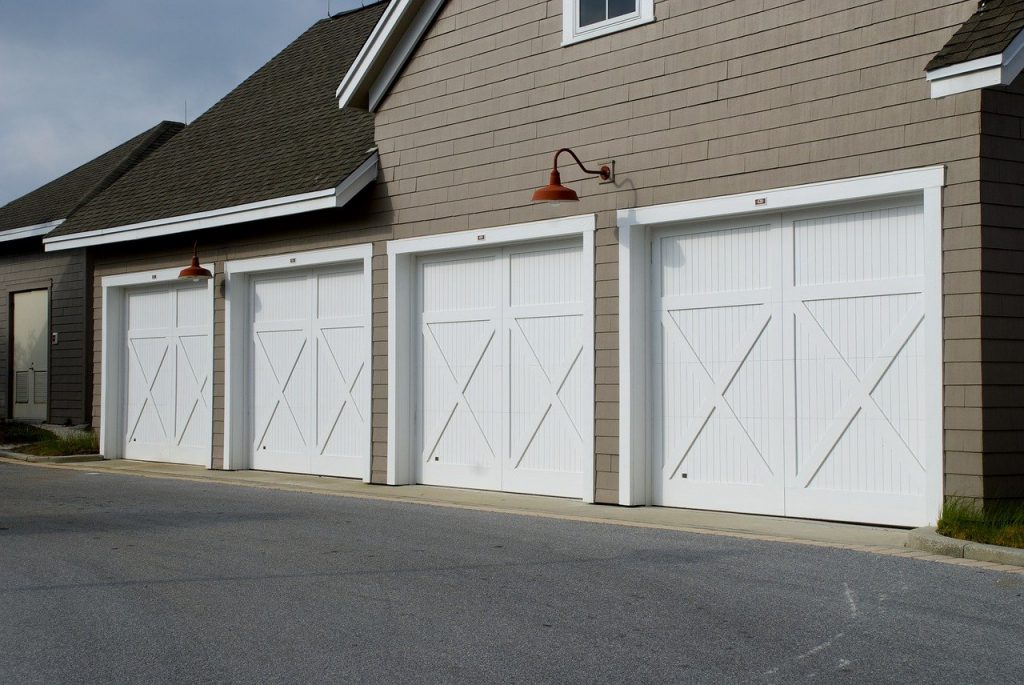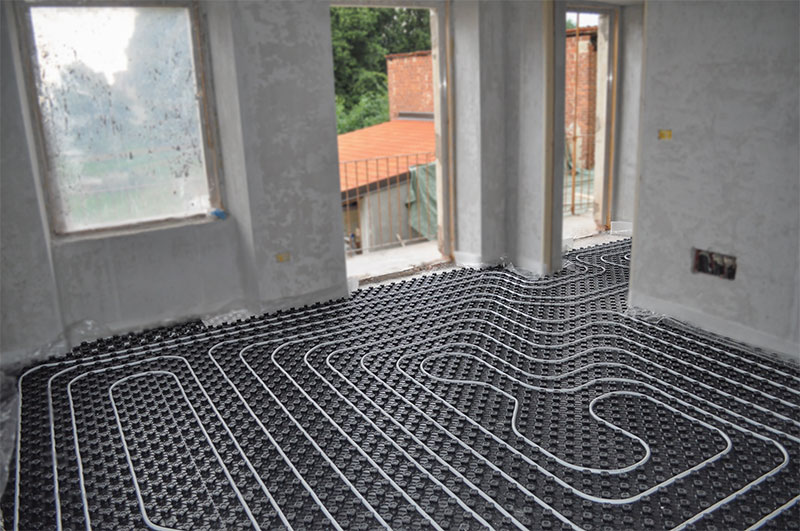Are you tired of working on your vehicles while lying on a cold, damp floor? Is your garage musty and humid? If you’re like most people, the thought of adding heat to your garage is not a consideration because you are concerned that it would be too expensive or take up too much space.
There is an option that is reasonably priced, energy-efficient, and will provide dry, warm floors for your garage in the winter: Radiant floor heating. It’s not just for the living spaces in your home. If this sounds like a great idea, this article can help you get started.
5 Advantages of Radiant Floor Heating in a Garage
Radiant floor heat is provided by electric cables installed under the surface of your garage slab. The heat from the cables warms the entire floor and then radiates that heat upward, warming the people and objects by a combination of infrared waves and convection. Radiant floor heating provides balanced heat throughout the garage without creating the cold spots that most other systems leave behind.
1. Energy Efficiency
Radiant floor heating also provides improved energy efficiency because the source of the heat is in direct contact with the floor and the heat is distributed evenly across the entire garage. Once the garage reaches the desired temperature, the concrete floor holds that heat much longer and slowly releases it. This allows the system to turn off and on less frequently than more conventional heating methods, saving you money.
2. No Maintenance
Once installed, electric radiant floor heat is maintenance-free. There are no filters to change and no mechanical parts to break down.
3. Snow Control
If you live in an area that gets snow in the winter, you are familiar with finding puddles of water in your garage as the snow melts from your vehicle. By heating the garage floor instead of the air in the garage, snow quickly melts and evaporates leaving you with a safe, dry floor.
4. Low-Profile, Discreet System
Whether you are using a radiant floor heating system in a new build or in a remodel, the installation requires very little additional floor height. In the case of new construction, the electric cables are installed directly in the concrete during the pour. For remodels, the system is usually buried in about 2” of new concrete. There are no visible signs that a heating system exists and the benefits are enjoyed without the noise of fans.
5. Low Cost
Electric radiant heat is competitively priced with other permanent heating solutions, but less expensive to operate over the long run. Combined with a Smart thermostat that actively controls off and on times by monitoring your needs and temperature swings, you can enjoy low-cost heat throughout the winter. Compared to an underfloor hydronic system, electric radiant heating offers much lower upfront costs.
How Does Electric Radiant Heating Compare to Other Systems?
Modern electric radiant heating is simply more efficient in providing balanced, low-cost heat to your entire garage than most systems. Since the entire floor is heated, the room is evenly warmed as the heat rises throughout the garage. Other systems will create a circular air flow that starts with the heat source and moves around the room instead of warming it all at once. If one of your goals is to have a warm floor, none of the other options warm the floor adequately since they heat the air first.
Forced Air
This term normally applies to HVAC systems also known as central heating. Forced air systems take up a great deal of space inside your home and outside, are noisy and require regular maintenance to operate at peak efficiency. They stir up dust and allergens as they heat the garage and in most cases will need to provide heat through ductwork to ceiling vents. Heat that starts at the ceiling has a hard time heating the air below it efficiently.
Infrared Heaters
Infrared heaters operate on a similar basis as radiant floor heating but are much smaller and therefore are not able to provide even heat throughout a large space like a garage. Since they heat objects and people first, rather than air, vehicles or equipment directly in their path would warm up before anything else.
Space Heaters
Space heaters can be fueled with gas or electricity. Electric units are generally portable and provide warmth primarily at the heater location. In order to properly heat a garage you would need more than one, or a large unit that would have to be ceiling mounted to be safe. Gas heaters are usually ceiling mounted. Systems that deliver heat to the ceiling first must run longer and less efficiently to warm up the air in the lower part of the room. This problem is called stratification.
Convection Heaters
A convection heater relies on natural air movement to operate. The heat source warms the air around it causing it to rise which brings the cold air in behind it to be heated. As with the other systems mentioned above, cold spots and stratification are issues as a convection heater relies completely on normal air movement to distribute the heat.
Hydronic Heating Systems
Underfloor hydronic heating systems are a relative of electric systems in that they provide similar radiant heating benefits from the ground up. However, the two types of radiant heating are different in many ways. For starters, electric systems are much more affordable to install and do not require any maintenance during their lifetime. Hydronic systems may need cleaning or maintenance since they are forcing water through underfloor pipes. Hydronic systems are typically considered more labor-intensive to install and take longer times to heat a room.
6 Tips for Installing Garage Radiant Flooring
Here are some steps to take to make sure you choose the best radiant floor system for your garage:
1. Calculate Garage Floor Heating Energy Requirements
To determine how much heat will be needed, follow these simple calculations:
- Calculate the square footage of garage space to be heated.
- Multiply that number times .09 (ex. 500 x .09 = 450).
- To arrive at the average size of the system needed (wattage), multiply that times 12 (450 x 12= 5,400 watts).
2. Install Over Existing Flooring or Coordinate with a New Flooring Installation
If you are adding radiant heating to an existing garage, Warmup recommends using the DCM-PRO cable or DWM mat with Ultralight insulation board.
- DCM-PRO: A decoupling system that utilizes a peel-and-stick mat (or fleece-backed) that would attach to the existing garage slab. The mat allows for some lateral movement in the subfloor below without cracking the finished layer of concrete above. The cable is run through the mat and after testing, 2” of concrete is poured over to finish the installation.
- DWM with Ultralight Insulation Board: This system consists of a net-type mat that has the heat cable already attached. The insulation board is applied on top of the existing garage floor to keep heat loss to the subfloor at a minimum. The insulation board is only ¼” thick so it does not add substantially to the floor height. The mat has a sticky back that will adhere to the insulation board. Once connected and tested, pour up to 2” of concrete to finish the floor.
For new construction, Warmup recommends using the Inslab system (WODH). This application uses heat cable without a mat that is zip-tied to the wire mesh during the initial pouring of the garage floor. The system is designed to work under 2-6 inches of concrete. The cable can be spaced up to 2” apart depending upon the wattage requirements.
3. Extend Radiant Heating Onto the Driveway
If you live in an area that receives a lot of snow and ice, you may want to consider adding radiant heating to the driveway. The systems detailed above would work well for this type of application.
4. Ensure the Space is Properly Sealed and Insulated
For any heating system to operate at peak efficiency, the area to be heated needs to be properly insulated and sealed. For newer homes, this is not a problem as most building codes require insulated windows, doors, walls and ceilings. If your home is more than 20 years old, you should check these areas to see if they have been insulated and sealed. A trip around the exterior of the garage with a caulk gun can eliminate any obvious areas of air leakage, but you may have to dig a little more to determine the insulation in your walls and ceiling.
5. Choose a Heating-Compatible Flooring Material
Most garage floors are concrete and the radiant heat systems described work well with this material. If you are painting over the concrete, make sure that the paint is compatible with a heated floor.
6. Consult a Professional Before Installation
Warmup electric radiant heat systems are simple in their design, but they should be installed by licensed electricians or heating contractors. These professionals can also make sure you have the right system for your particular project.
Upgrade Your Garage With Radiant Heating
Warmup is the number one provider of electric radiant heat products in the world and offers the best warranties in the industry to back their products. If you are considering radiant heat for your new home or are in the process of a remodel, contact us today for more information on best practices for heating a garage and to get a free quote.










